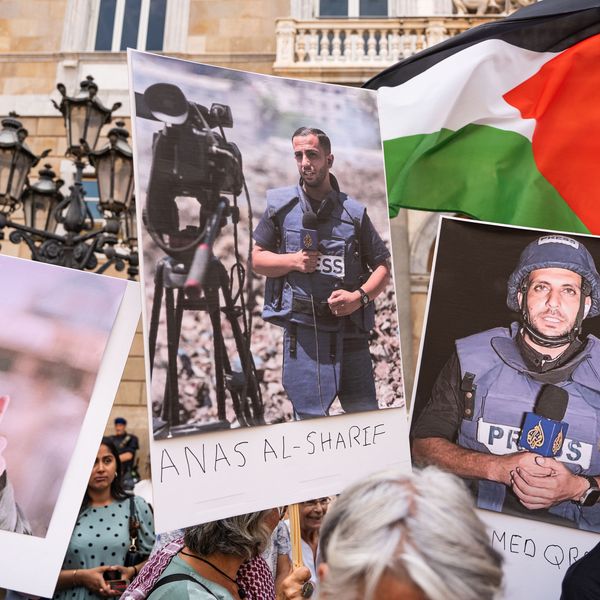Reflecting 'Global Surge in Authoritarianism,' 2014 Marks a Brutal Year for Journalists
Annual reports by leading press freedom groups reveal 66 journalists slain, 220 imprisoned in 2014
2014 has been a grim year for journalists. Two leading press freedom groups have released their annual reports on the abuse and imprisonment of journalists around the globe and the evidence paints a world increasingly "barbaric" for those seeking to report on global events.
Reflecting what the group says is a "global surge in authoritarianism," the annual census by the international nonprofit Committee to Protect Journalists has found that, for the third year in a row, more than 200 journalists are behind bars.
The CPJ report, published Wednesday, says that 220 journalists are currently in government custody, marking the second highest number of imprisoned journalists worldwide since the group began keeping records in 1990.
Of those jailed, 132 journalists, or 60 percent, are being held on anti-state charges such as "subversion" or "terrorism." Further, there have been no charges disclosed for 20 percent of the journalists held. According to the tally, with 44 imprisoned journalists, China tops the list as the "world's worst jailer of 2014," with Iran as second, with 33.
CPJ's prison tally only includes those being held by the government and not those in custody of nonstate actors, such as the Islamic State (or ISIS), nor does it include those identified as "missing" or "abducted."
Reporters Without Borders' annual roundup of abuses against journalists, published Tuesday, found that 66 journalists were murdered this year and a total of 119 were kidnapped, an increase of more than 35% from 2013. According to their estimates, 40 journalists are currently being held hostage.
The numbers, the group writes, "highlight an evolution in the nature of violence against journalists and the way certain kinds, including carefully-staged threats and beheadings, are being used for very clear purposes."
"The murders are becoming more and more barbaric and the number of abductions is growing rapidly," the report continues, "with those carrying them out seeking to prevent independent news coverage and deter scrutiny by the outside world."
Worldwide, 1,846 journalists and citizen-journalists have either been threatened or attacked this year, often by either protesters or police during demonstrations that turned violent.
The "sharp increase" in the number of kidnappings took a large toll on local reporters. In contrast to international journalists, up to 90% of those abducted in 2014 were locally-based correspondents.
The five most dangerous areas to be a reporter, according to RWB, are: Territories controlled by ISIS; Eastern Libya; Pakistan's "biggest and poorest providence," Balochistan; eastern Ukraine; and northwest Colombia.
An Urgent Message From Our Co-Founder
Dear Common Dreams reader, The U.S. is on a fast track to authoritarianism like nothing I've ever seen. Meanwhile, corporate news outlets are utterly capitulating to Trump, twisting their coverage to avoid drawing his ire while lining up to stuff cash in his pockets. That's why I believe that Common Dreams is doing the best and most consequential reporting that we've ever done. Our small but mighty team is a progressive reporting powerhouse, covering the news every day that the corporate media never will. Our mission has always been simple: To inform. To inspire. And to ignite change for the common good. Now here's the key piece that I want all our readers to understand: None of this would be possible without your financial support. That's not just some fundraising cliche. It's the absolute and literal truth. We don't accept corporate advertising and never will. We don't have a paywall because we don't think people should be blocked from critical news based on their ability to pay. Everything we do is funded by the donations of readers like you. Will you donate now to help power the nonprofit, independent reporting of Common Dreams? Thank you for being a vital member of our community. Together, we can keep independent journalism alive when it’s needed most. - Craig Brown, Co-founder |
2014 has been a grim year for journalists. Two leading press freedom groups have released their annual reports on the abuse and imprisonment of journalists around the globe and the evidence paints a world increasingly "barbaric" for those seeking to report on global events.
Reflecting what the group says is a "global surge in authoritarianism," the annual census by the international nonprofit Committee to Protect Journalists has found that, for the third year in a row, more than 200 journalists are behind bars.
The CPJ report, published Wednesday, says that 220 journalists are currently in government custody, marking the second highest number of imprisoned journalists worldwide since the group began keeping records in 1990.
Of those jailed, 132 journalists, or 60 percent, are being held on anti-state charges such as "subversion" or "terrorism." Further, there have been no charges disclosed for 20 percent of the journalists held. According to the tally, with 44 imprisoned journalists, China tops the list as the "world's worst jailer of 2014," with Iran as second, with 33.
CPJ's prison tally only includes those being held by the government and not those in custody of nonstate actors, such as the Islamic State (or ISIS), nor does it include those identified as "missing" or "abducted."
Reporters Without Borders' annual roundup of abuses against journalists, published Tuesday, found that 66 journalists were murdered this year and a total of 119 were kidnapped, an increase of more than 35% from 2013. According to their estimates, 40 journalists are currently being held hostage.
The numbers, the group writes, "highlight an evolution in the nature of violence against journalists and the way certain kinds, including carefully-staged threats and beheadings, are being used for very clear purposes."
"The murders are becoming more and more barbaric and the number of abductions is growing rapidly," the report continues, "with those carrying them out seeking to prevent independent news coverage and deter scrutiny by the outside world."
Worldwide, 1,846 journalists and citizen-journalists have either been threatened or attacked this year, often by either protesters or police during demonstrations that turned violent.
The "sharp increase" in the number of kidnappings took a large toll on local reporters. In contrast to international journalists, up to 90% of those abducted in 2014 were locally-based correspondents.
The five most dangerous areas to be a reporter, according to RWB, are: Territories controlled by ISIS; Eastern Libya; Pakistan's "biggest and poorest providence," Balochistan; eastern Ukraine; and northwest Colombia.
2014 has been a grim year for journalists. Two leading press freedom groups have released their annual reports on the abuse and imprisonment of journalists around the globe and the evidence paints a world increasingly "barbaric" for those seeking to report on global events.
Reflecting what the group says is a "global surge in authoritarianism," the annual census by the international nonprofit Committee to Protect Journalists has found that, for the third year in a row, more than 200 journalists are behind bars.
The CPJ report, published Wednesday, says that 220 journalists are currently in government custody, marking the second highest number of imprisoned journalists worldwide since the group began keeping records in 1990.
Of those jailed, 132 journalists, or 60 percent, are being held on anti-state charges such as "subversion" or "terrorism." Further, there have been no charges disclosed for 20 percent of the journalists held. According to the tally, with 44 imprisoned journalists, China tops the list as the "world's worst jailer of 2014," with Iran as second, with 33.
CPJ's prison tally only includes those being held by the government and not those in custody of nonstate actors, such as the Islamic State (or ISIS), nor does it include those identified as "missing" or "abducted."
Reporters Without Borders' annual roundup of abuses against journalists, published Tuesday, found that 66 journalists were murdered this year and a total of 119 were kidnapped, an increase of more than 35% from 2013. According to their estimates, 40 journalists are currently being held hostage.
The numbers, the group writes, "highlight an evolution in the nature of violence against journalists and the way certain kinds, including carefully-staged threats and beheadings, are being used for very clear purposes."
"The murders are becoming more and more barbaric and the number of abductions is growing rapidly," the report continues, "with those carrying them out seeking to prevent independent news coverage and deter scrutiny by the outside world."
Worldwide, 1,846 journalists and citizen-journalists have either been threatened or attacked this year, often by either protesters or police during demonstrations that turned violent.
The "sharp increase" in the number of kidnappings took a large toll on local reporters. In contrast to international journalists, up to 90% of those abducted in 2014 were locally-based correspondents.
The five most dangerous areas to be a reporter, according to RWB, are: Territories controlled by ISIS; Eastern Libya; Pakistan's "biggest and poorest providence," Balochistan; eastern Ukraine; and northwest Colombia.

